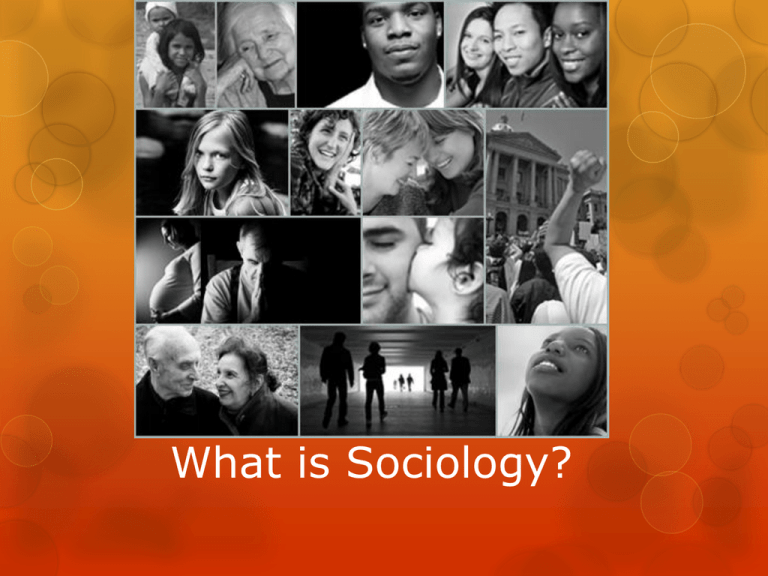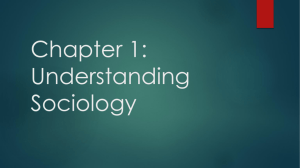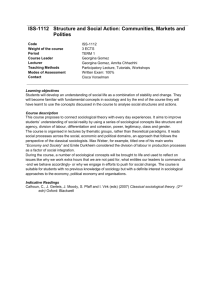What is Sociology Powerpoint
advertisement

What is Sociology? Sociology Is the study of human society and social interaction. Sociologists try to develop theories about the interrelationship between group life and the individual Is important to study because it shows how individual behavior is shaped by our society and the larger global context in which our society is located. Used to understand human behavior based on science What sociologists study „Culture „Socialization „Stratification (social inequality, income) „Race & gender (stereotypes) „Deviance & crime „Family „Religion The Sociological “Lens” Example—Death Penalty A social behavior—How would different social sciences look at it? Psychology Political science Sociology The Sociological “Lens” ExampleSuicide Is it an individual or societal issue? How does it vary geographically? Teen suicide in the US v Jihadist Suicide “The Sociological Imagination” Sociologists often refer to the ability to see the connection between individual behavior and the larger social context as the sociological imagination. The sociological imagination helps to distinguish between person troubles and public issues. Personal troubles affect the individual and his/her networks and require that a person create a solution, while public issues affect large numbers of people and may require sociological solutions. Sociological Imagination Example: Single mother Rita Harris has been working as a software engineer in Hartford, CT for 10 years. Her job was outsourced to India. She blames herself for not working hard enough. Is it really her fault? 80% of Americans carry some form of debt- credit card, mortgage, college loan, etc. As a country, we have the propensity to overspend. Is this a personal or public issue? In the last 10 years, a majority of young Americans wait until their late 20s and early 30s to get married. The Benefits of Studying Sociology It is a way to appreciate our own society from the outsider’s perspective It allows us to understand problems from a wider perspective MACRO (big) level “top down” approach MICRO (small) level “bottom up” approach Sociological Questions: How do people differ? By race, or the way people are distinguished by physical characteristics such as skin color By ethnicity, or their cultural heritage or identity based on factors such as language or country of origin By class, or their relative location within the larger society based on wealth, power, prestige, or other values resources By gender, or the meanings, beliefs, and practices associated with sex differences Modern Sociological Perspectives 1. Structural-Functional 2. Social Conflict 3. Symbolic Interactionism Functionalism Society is like a living organism Living organism has parts All parts together make a living organism All parts are important in maintaining a balance (nothing is trivial) Functionalism Parts of living organism such as human body Hands, feet, legs, arms, eyes, kidney, digestive system, etc. playing important role in making life possible (they all have a specific FUNCTION) Society develops social structures or institutions that keep society surviving Education, religion, government, economy, and family structures When adverse conditions affect one institution, they affect all institutions (for example- terrible family life will impact the school performance of kids) Functionalism Examples… Poverty Crime/delinquency Prostitution How are they functional? (adding to the stability) Functionalism When a part of society undermine the stability it is no longer functional It is “dysfunctional”—adding to the instability of the society When crime, prostitution, poverty are out of control they are dysfunctional Equilibrium Equilibrium is the state of balance maintained by social processes that help society adjust and compensate for forces that might tilt it onto a path of destruction Conflict Social behavior best understood in terms of conflict or tension Groups compete for control of scarce resources in society Inspired by Karl Marx Functionalism looks for “stability” whereas conflict sociology looks tension in society Conflict Everyone is society is competing for power and resources Apply it to Shopping Development of Conflict Sociological Lens Marx—division of society into “owners” and “workers” Continuous conflict between the two classes ending in revolution Group membership determine behavior & attitude Interaction Perspective Social behavior is better understood in terms of interaction among people Interactions take place through symbols—verbal & nonverbal communication “Walk the world in someone else’s shoes” Interaction Dramaturgical approach (Goffman)—everyday life is like a theater and stage We wear a series of masks and act different ways in different situations- its our interaction with the environment and each other Interactionists focus on people’s face to face interactions and the roles people play Customers who interact with cashiers rely on previous experiences to guide the interaction Why do we spend money to impress others? What symbols do we use to improve our interactions with others? Goffman’s Dramaturgical Analysis Methods used to market status, sex, and success? Social Disintegration Social Integration is the degree to which people are connected to their social groups. Anomie is a state of relative normlessness that comes from the disintegration of our routines and regulations. -Anomie is common when we go through sudden changes in our lives or when we live in larger cities. -Sudden changes bring stress and frustration. Anomie at Graduation To illustrate this, I often tell my students to remember how they felt the day after high school graduation. They walk for graduation then wake up the next morning with very few demands on their time and energies. This sudden shift in demands from very intense to almost absent, leads many to feel extremely frustrated and lost. Add to that they are now adults and no longer students (children) and you get a prime formula for anomie (role shift + vague expectations about what is expected + sudden change=anomie). Irish Anomie“feeling like they don’t belong” Theory Puzzles You will paired up with a classmate. You will be given an envelope containing little puzzle pieces. Your job is to organize the pieces until you have created six squares. Each square corresponds to a category- sports, health, family, age, environment, and religion. Once you have finished the puzzles, raise your hand and I will come around and tell you the next step (and give you a handout which I will collect for participation credit) Theory Puzzles Structural- Functional Society is seen as a system whose parts work together in order to promote solidarity and stability. There are stable patterns of social behavior, and all structures have consequences which serve as a function for society. Social Conflict Society is seen as a structure that is full of inequality. This massive inequality generates conflict and is the motivation for change. All social structures benefit the elite (the wealthy) and further deprive the poor. Symbolic Interaction Society is the product of everyday interaction of individuals. It is complex, changing, and subject to their own views, experiences, memories, thoughts, and expectations. Social Issues Skit Each group will be assigned the task of coming up with a two minute skit about your social issue. You have 15 minutes to come up with a skit. Marriage Homelessness War Physical abuse Euthanasia Drug Abuse Crime Social Issues Skit Reflections The room will be divided up into three theory teamsstructural-functional, social conflict, and symbolic interaction. Each group will present their skit. After viewing each skit, each theory team will have two minutes to develop an explanation of, or opinion on, the issue presented according to your assigned theory. A representative from your team will then present their theory to the class.





